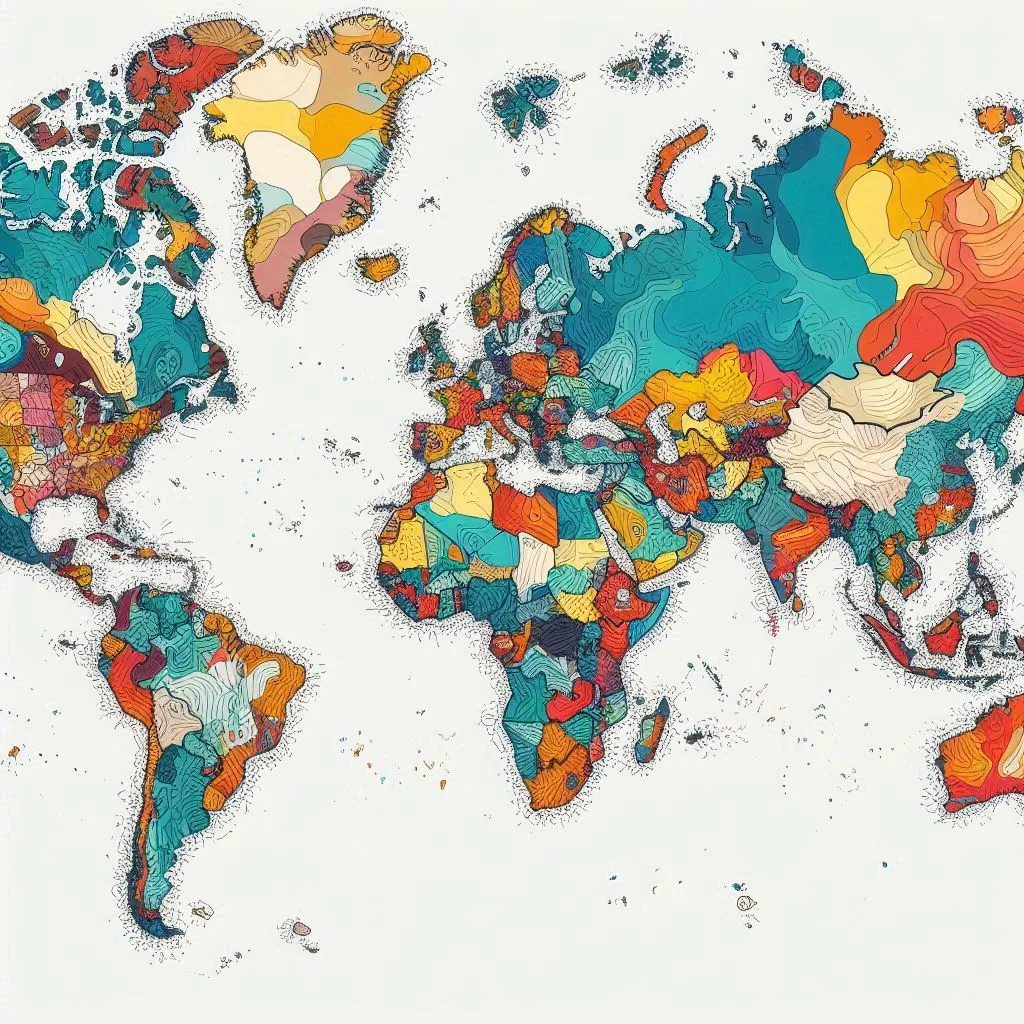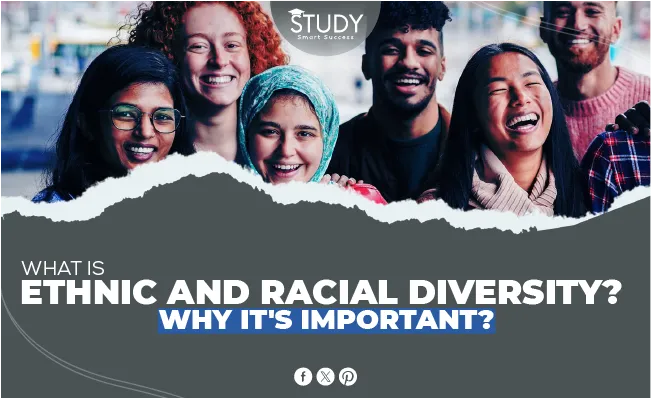Introduction
“Diversity doesn’t mean how we vary. Diversity is about accepting each other’s differences.” Ola Joseph’s observation underscores a global trend: diversification. By 2050, the UN predicts demographic shifts that will make many countries more ethnically and racially diverse.
Diversity issues in education, industry, government, and community organizations have grown. This increased attention emphasizes the need to comprehend and accept ethnic and racial diversity’s complexity.
This blog will define ethnic and racial diversity and explain its importance. It will also discuss diversity’s social, cultural, economic, and educational benefits and worldwide viewpoints. We will also discuss diversity myths and challenges to understand its importance in our increasingly interconnected society fully.
Defining Ethnic and Racial Diversity
What is Ethnic Diversity?
Ethnic diversity refers to the diversity of ethnic groups in a population. Standard cultural practices, languages, traditions, and historical experiences define these groupings. Cultural heritage and common identity distinguish ethnic groupings from racial groups based on physical traits.
Examples:
- Hispanic/Latino: This ethnic group encompasses Latin American and Spanish people with distinct traditions, cuisines, and languages. Examples include Mexicans commemorating deceased loved ones on Día de los Muertos and Argentinians’ love of tango and soccer.
- Han Chinese: The Han Chinese, China’s largest ethnic group, are recognized for their rich history, language (Mandarin), and cultural customs, such as dragon dances, fireworks, and traditional feasts during Chinese New Year.
- Maasai: Maasai people in Kenya and Tanzania are known for their colorful shukas, semi-nomadic lifestyle, and culture. Traditional dances and rites, such as Eunoto (warrior initiation), are essential to their culture.

What is Racial Diversity?
Definition:
Racial variety is the prevalence of diverse racial groupings in a population, typically defined by genetically driven skin color, hair texture, and facial traits. Racial variety emphasizes biological and physical qualities, unlike ethnic diversity, which emphasizes culture and history.
Examples:
- Caucasian (White): This race mainly consists of Europeans. Hair hues, textures, lighter skin tones, and various eye colors are typical. Cultural representations differ from Scandinavian to the Mediterranean.
- African (Black): Africans are in this category. Standard features include darker skin and different hair textures. This group’s culture is rich, from West African drumming and dance to African American jazz and blues.
- Asian: This broad racial categorization includes East Asians, Southeast Asians, and Indians. Variations in skin tone, dark hair, and facial features are standard. Traditional Japanese tea ceremonies and lively Indian festivities are among this group’s various cultures.
- Indigenous Peoples: First Nations in Canada, Aboriginal Australians, and Native Americans in the US fall into this category. Native American storytelling and Aboriginal Australian Dreamtime art are examples of these tribes’ deep connection to their ancestral territories and unique cultural practices.
Racial diversity is vital for understanding the wide range of human experiences and working to make society more fair and open to everyone.

The Importance of Ethnic and Racial Diversity
Social and Cultural Benefits
Cultural Exchange:
Cultural exchange occurs when people of different ethnicities and races share their traditions, languages, and practices. Exchange broadens perspectives and fosters mutual respect and understanding, enriching societies. Multicultural festivals showcase many cultures through food, music, dance, and art, allowing people to appreciate them.
Community Strength:
Diversity fosters social cohesiveness and innovation. Different perspectives and problem-solving methods emerge when diverse people gather. Diversity of ideas fosters creativity and community resilience. Additionally, inclusive communities manage social challenges better because they consider more experiences and opinions.
Examples:
- Toronto, Canada: One of the world’s most multicultural cities, Toronto’s diversity is a strength. Caribbean culture is celebrated at Caribana, and global film is shown at the Toronto International Film Festival. Culture makes Toronto a vibrant and dynamic city that attracts people worldwide.
- Singapore: Chinese, Malay, Indian, and Eurasian people live here. Multicultural education and public housing in Singapore foster racial harmony and integration. Diversity has created a stable and cohesive society, proving its benefits.
- San Francisco, USA: San Francisco San Francisco’s diverse population fosters innovation and creativity. Silicon Valley’s diverse workforce, which includes talent from around the world, drives innovation and economic progress.
Cultural interchange, community strength, and innovation are enhanced by ethnic and racial variety. These benefits make society more lively, robust, and inclusive, allowing everyone to prosper.
Economic Advantages
Workforce Diversity:
Diverse viewpoints and experiences in the workplace increase creativity, problem-solving, and productivity. When diverse employees cooperate, they bring new perspectives, leading to better solutions and decisions. According to research, diverse teams are better at predicting market trends, finding opportunities, and adapting to changing conditions.
Market Reach:
Businesses can use diversity to reach new customers and markets. By recognizing and representing demographic group needs and preferences, companies can tailor their products and services to a varied client base, boosting market share, brand loyalty, and reputation. Diverse teams can better handle cultural differences and engage with consumers from varied backgrounds, enhancing customer happiness and retention.
Case Studies:
- Procter & Gamble (P&G): P&G encourages diversity and inclusion because it believes it boosts innovation and growth. Due to its diversified staff and markets, the corporation can make products that appeal to various consumers. Diversity campaigns like “My Black is Beautiful” encourage Black women and generate brand loyalty for P&G.
- Google: Google values diversity and inclusion in hiring because various viewpoints drive creativity. The organization recruits diverse candidates and promotes an inclusive atmosphere where everyone is heard. Google Translate and YouTube are innovative goods and services created using this strategy for varied global markets.
Businesses can acquire a competitive edge and sustain economic growth by embracing workforce diversity and using it to understand and service varied markets. Case studies of Procter & Gamble and Google show how diversity drives creativity, market reach, and economic success.
Educational Enrichment
Inclusive Education:
An enriching education requires diverse perspectives. Inclusive education promotes belonging and engagement by including kids of all ethnicities and races in the curriculum.
This technique dispels prejudices and enhances cultural and historical awareness. By including varied perspectives and viewpoints, teachers may create a more dynamic and relevant learning environment that prepares students for a multicultural world.
Critical Thinking:
Different perspectives improve pupils’ critical thinking and empathy. Student interactions with varied peers inspire them to evaluate multiple perspectives and question their assumptions.
This method promotes openness and critical thinking. Understanding and empathizing with diverse cultures creates a more inclusive and courteous school atmosphere that benefits all kids.
Statistics:
- Academic Performance: Research shows that students in diverse educational contexts perform better academically. The Century Foundation showed that racially and economically diverse schools overcome performance gaps by improving all students’ test scores and college attendance.
- Student Engagement: The National Education Association (NEA) found that diverse classrooms engage students. Students participate more in class discussions and extracurricular activities when they feel represented and included. According to the NEA, Diverse schools have higher satisfaction and lower dropout rates.
- Empathy and Social Skills: According to APA data, students in diverse schools acquire better social skills and empathy. This prepares students to work collaboratively and politely with people from different backgrounds, which is essential for their future careers and personal life.
Diverse viewpoints increase learning and improve critical thinking and empathy in inclusive education. Diversity improves academic performance and student involvement, emphasizing the need for inclusive schools.
Global Perspectives
Global Connectivity:
People and companies seeking global success need variety in today’s interconnected world. Diverse teams can better communicate and work across borders because they understand and traverse different cultures.
This global connectivity lets organizations expand, enter international markets, and form strong alliances. Diversity helps people adapt and understand other cultures, which are crucial in a globalized employment environment.
Diplomatic Relations:
Diversity is essential to international cooperation. When people of different ethnicities and races interact, respect and empathy are built. Diplomacy relies on this knowledge to reduce conflicts and foster peace. Diverse diplomatic teams can better negotiate complicated global issues because they bring different cultural perspectives.
Examples:
- United Nations (UN): The UN exemplifies how diversity improves international cooperation. The UN’s diversified team addresses climate change, poverty, and human rights with representatives from nearly every country. The UN’s broad perspectives allow it to create comprehensive and culturally sensitive solutions that are more likely to be adopted.
- International Corporations: IBM and Coca-Cola have improved their global operations with diversity. IBM can innovate and adapt its goods to different markets because of its diversified workforce of over 170 countries. Coca-Cola’s international success is due to its diversified marketing teams’ culturally relevant campaigns.
- Scientific Research: Multinational scientific teams helped the Human Genome Project significantly. Diversity helped the research make essential genetics and biotechnology findings, showing how varied perspectives may advance science.
Diversity boosts global connectivity and diplomacy. Diversity promotes international collaboration and understanding by educating people and organizations about multiculturalism. Examples from the UN and global enterprises show how heterogeneous teams may succeed globally.
Conclusion
A vibrant, inclusive society requires ethnic and racial variety. Diversity boosts social and cultural diversity, economic growth, education, and globalization readiness. It celebrates human diversity and builds more robust, more resilient communities.
Cultural interchange, social cohesiveness, and creativity thrive in diverse contexts. They help firms expand their markets and use fresh viewpoints to boost productivity and innovation. Diversity improves learning, critical thinking, and multicultural preparedness. Diversity promotes global understanding and cooperation, which are necessary to solve complex international issues.
As we move forward, we must recognize diversity and actively build inclusive settings where everyone feels appreciated and respected. Doing so honors our humanity and creates a fairer future for all. Let us understand and champion diversity in all its manifestations, knowing that our differences make us strong.


